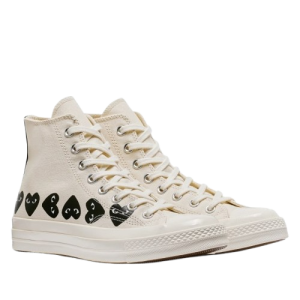Comme des Garçons, the iconic Japanese fashion label founded by Rei Kawakubo in 1969, has continually redefined the boundaries of fashion through its avant-garde aesthetics, conceptual design, and disregard for traditional norms. Translating to “Like Boys” in French, the brand’s name already signals its intent to challenge gender conventions and blur sartorial boundaries—an ethos that has driven its enduring influence in the world of high fashion.
Origins and Philosophy
The journey of Comme des Garçons began in Tokyo, where Rei Kawakubo—who had no formal training in fashion—began creating clothing under her own label. In 1973, the brand officially became a company, and within a few years, it garnered a cult following for its monochromatic palette, asymmetrical silhouettes, and raw, deconstructed garments. Kawakubo’s work often defies the idea of fashion as mere adornment. Instead, she uses clothing as a medium to express abstract ideas, emotions, and critiques of societal expectations.
When Comme des Garçons debuted in Paris in 1981, the reception was polarizing. With its all-black, torn, and seemingly unfinished designs, the collection was dubbed “Hiroshima chic” by Western critics who failed to grasp its depth. Yet this bold entry into the European fashion scene marked a turning point in the global perception of Japanese design and helped establish Paris as a second home for the brand.
Defying Convention
Comme des Garçons has always operated outside the conventional fashion system. Rather than chase trends or seasonal fads, Kawakubo constructs each collection around a central concept—whether it’s the imperfection of the human body, the absurdity of gender norms, or the exploration of void and chaos. Her garments are often architectural, sculptural, and abstract. They may not always be wearable in the traditional sense, but they provoke thought and stir emotion.
Kawakubo is famously private and enigmatic, letting her work speak for itself. This air of mystery adds to the brand’s allure, as fans and critics alike are left to interpret the deeper meanings behind her creations. In an industry often obsessed with branding and visibility, Comme des Garçons has carved a unique identity through substance and innovation.
Sub-Labels and Collaborations
Over the years, Comme des Garçons has expanded into various sub-labels, each with its own aesthetic and purpose. Perhaps the most commercially successful is Comme des Garçons PLAY, recognizable by its heart-with-eyes logo designed by Polish artist Filip Pagowski. PLAY appeals to a broader audience with its more casual and accessible designs, including T-shirts, sneakers, and collaborations with brands like Converse.
Other lines include Comme des Garçons Homme Plus (high-end menswear), Comme des Garçons Noir, and Comme des Garçons Shirt, each offering different facets of CDG Shirt Kawakubo’s vision. The brand has also launched and supported the careers of other designers under its umbrella, such as Junya Watanabe and Kei Ninomiya, reinforcing its influence as a fashion incubator.
Cultural Impact
Comme des Garçons is more than a fashion label—it is a cultural force. Its shows are highly anticipated not only for the clothes but for the philosophical narratives and visual storytelling. The brand’s commitment to pushing boundaries has inspired generations of designers, artists, and thinkers who see fashion as a form of artistic expression rather than a commercial product.
In 2017, Kawakubo became only the second living designer (after Yves Saint Laurent) to be honored with a solo exhibition at the Metropolitan Museum of Art’s Costume Institute. The exhibition, titled Rei Kawakubo/Comme des Garçons: Art of the In-Between, celebrated her work as art, further blurring the line between fashion and fine art.
Conclusion
Comme des Garçons stands as a testament to the power of vision, risk-taking, and authenticity in fashion. Rei Kawakubo’s fearless approach has turned the brand into a beacon of innovation, challenging not only how we dress, but how we think about identity, beauty, and expression. In a world of fast fashion and fleeting trends, Comme des Garçons remains a radical, enduring voice—one that continues to shape the future of style through thoughtful disruption.
Want me to tailor it more toward a specific audience or platform (e.g., fashion students, blog readers, magazine article)?







